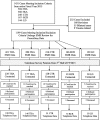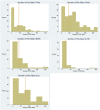Excess Opioid Medication and Variation in Prescribing Patterns Following Common Orthopaedic Procedures
- PMID: 29406338
- PMCID: PMC6818977
- DOI: 10.2106/JBJS.17.00672
Excess Opioid Medication and Variation in Prescribing Patterns Following Common Orthopaedic Procedures
Abstract
Background: Postoperative pain management in orthopaedic surgery accounts for a substantial portion of opioid medications prescribed in the United States. Understanding prescribing habits and patient utilization of these medications following a surgical procedure is critical to establishing appropriate prescribing protocols that effectively control pain while minimizing unused opioid distribution. We evaluated prescribing habits and patient utilization following elective orthopaedic surgical procedures to identify ways of improving postoperative opioid-prescribing practices.
Methods: We performed a review of prescribing data of 1,199 procedures and gathered telephone survey results from 557 patients to determine the number of opioid pills prescribed postoperatively and the number of unused pills. The data were collected from adult patients who underwent 1 of the 5 most common elective orthopaedic procedures at our institution in fiscal year 2015: total hip arthroplasty, total knee arthroplasty, endoscopic carpal tunnel release, arthroscopic rotator cuff repair, or lumbar decompression. We converted all dosages to opioid equivalents of oxycodone 5 mg and performed analyses of prescribing patterns, patient utilization, and patient disposal of unused opioids.
Results: Prescribing patterns following the 5 orthopaedic procedures showed wide variation. The median numbers of oxycodone 5-mg equivalent opioid pills prescribed upon discharge were 90 pills (range, 20 to 330 pills) for total hip arthroplasty, 90 pills (range, 10 to 200 pills) for total knee arthroplasty, 20 pills (range, 0 to 168 pills) for endoscopic carpal tunnel release, 80 pills (range, 18 to 100 pills) for arthroscopic rotator cuff repair, and 80 pills (range, 10 to 270 pills) for lumbar decompression. Thirty-seven percent of patients overall requested and received at least 1 refill. The mean number of total pills prescribed (and standard deviation) including refills was 113.6 ± 75.7 for total hip arthroplasty, 176.4 ± 108.0 for total knee arthroplasty, 24.3 ± 29.0 for carpal tunnel release, 98.2 ± 59.6 for rotator cuff repair, and 107.4 ± 64.4 for lumbar decompression. Participants reported unused opioid medication in 61% of cases. During the study year, >43,000 unused opioid pills were prescribed. Forty-one percent of patients reported appropriate disposal of unused opioid pills.
Conclusions: Prescribing patterns vary widely, and a large amount of opioid medications remains unused following elective orthopaedic surgical procedures. Effective prescribing protocols are needed to limit this source of potential abuse and opioid diversion within the community.
Figures





Comment in
-
Opioids After Orthopaedic Surgery: There Is a Need for Universal Prescribing Recommendations: Commentary on an article by Matthew J. Sabatino, MD, MS, et al.: "Excess Opioid Medication and Variation in Prescribing Patterns Following Common Orthopaedic Procedures".J Bone Joint Surg Am. 2018 Feb 7;100(3):e17. doi: 10.2106/JBJS.17.01480. J Bone Joint Surg Am. 2018. PMID: 29406353 No abstract available.
References
-
- Centers for Disease Control and Prevention. Understanding the epidemic. 2016. https://www.cdc.gov/drugoverdose/epidemic/. Accessed 2017 Nov 13.
-
- Portenoy RK. Continuous infusion of opioid drugs in the treatment of cancer pain: guidelines for use. J Pain Symptom Manage. 1986. Fall;1(4):223-8. - PubMed
-
- Portenoy RK, Foley KM. Chronic use of opioid analgesics in non-malignant pain: report of 38 cases. Pain. 1986. May;25(2):171-86. - PubMed
-
- Morris BJ, Mir HR. The opioid epidemic: impact on orthopaedic surgery. J Am Acad Orthop Surg. 2015. May;23(5):267-71. - PubMed
-
- Department of Veterans Affairs. Pain as the 5th vital sign toolkit. 2000. Octoberhttps://www.va.gov/PAINMANAGEMENT/docs/Pain_As_the_5th_Vital_Sign_Toolki.... Accessed 2017 Nov 9.
MeSH terms
Substances
Grants and funding
LinkOut - more resources
Full Text Sources
Other Literature Sources
Medical

